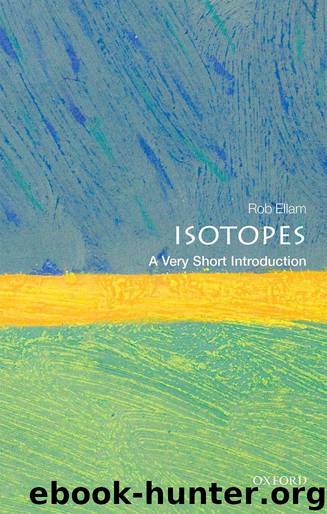Isotopes: A Very Short Introduction by Rob Ellam

Author:Rob Ellam
Language: eng
Format: epub
ISBN: 9780198723622
Publisher: OUP Oxford
Published: 2016-04-09T04:00:00+00:00
Thermal ionization mass spectrometers
Heavier elements such as the alkali metals, alkali earths, and rare earths are typically ionized by thermal ionization mass spectrometry (TIMS). To minimize isobaric interferences and to maximize ionization efficiency, TIMS sources need to be highly purified. As described in Chapter 4 for α-spectrometry, purification is usually achieved by ion exchange chromatography. Processing of the sample is performed in an ultra-clean laboratory usually supplied with filtered air that creates an over-pressured cleanroom designed to prevent dirty air entering the lab. Chemical reagents are ultra-clean, and most laboratories take commercially available acids and clean them further by sub-boiling distillation in Teflon stills. Laboratory water is totally deionized by reverse osmosis systems costing thousands of pounds, and the lab scientists typically wear cleanroom overalls, hoods, overshoes, and gloves, which serve the dual role of preventing sample contamination and protecting the chemist from hazardous strong acids—the most challenging samples need the most hazardous mineral acids (e.g. hydrofluoric and perchloric to effect dissolution).
All these provisions are necessary because we are dealing with tiny amounts of sample material and trying to extract elements which are also present in the environment without contaminating the sample. For instance, in my lab we analyse lead (Pb) in rocks like basalt. Concentrations are typically a few parts per million (ppm) or microgrammes (μg) per gramme (g), and we digest about 50 milligrammes (mg) of powdered rock. So, for a 5 ppm rock, assuming we extract 100 per cent of the Pb, the final sample is (i.e. or 250 nanogrammes (ng)). I like to keep the ratio of sample to ‘blank’ (i.e. contamination) greater than 1,000/1, so no more than 0.1 per cent of the final samples is environmental contamination, so we need blanks that are less than 250 picogrammes (pg). More challenging applications require even better blanks and it is possible to push Pb to a few picogrammes. Actually, Pb blanks have become easier since the abolition of lead additives in petrol. However, my lab is about 50 metres (m) down the corridor from the nuclear spectroscopy lab where there are industrial amounts of Pb shielding, so I need to be careful where I go and what I touch!
TIMS samples emerge from the chemistry laboratory as a tiny spot of the element of interest usually as a chloride or nitrate in the bottom of a Teflon beaker. We pick the sample up in a microlitre of acid and place it on a mass spectrometer filament made of a metal capable of being heated to high temperature without melting and with a relatively low tendency for thermionic emission of electrons, typically rhenium, tantalum, or tungsten (Figure 13). We dry the sample by putting a current through the filament and then load the sample into a barrel which carries as many as twenty samples that can be analysed one after another. Loading several samples at once reduces the number of times the mass spectrometer ion source is vented to atmospheric pressure between barrels. The size of individual barrels
Download
This site does not store any files on its server. We only index and link to content provided by other sites. Please contact the content providers to delete copyright contents if any and email us, we'll remove relevant links or contents immediately.
Man-made Catastrophes and Risk Information Concealment by Dmitry Chernov & Didier Sornette(5659)
The Revenge of Geography: What the Map Tells Us About Coming Conflicts and the Battle Against Fate by Kaplan Robert D(3964)
Zero Waste Home by Bea Johnson(3659)
In a Sunburned Country by Bill Bryson(3374)
Good by S. Walden(3354)
COSMOS by Carl Sagan(3353)
The Fate of Rome: Climate, Disease, and the End of an Empire (The Princeton History of the Ancient World) by Kyle Harper(2878)
Camino Island by John Grisham(2722)
A Wilder Time by William E. Glassley(2694)
Organic Mushroom Farming and Mycoremediation by Tradd Cotter(2568)
The Ogre by Doug Scott(2506)
Human Dynamics Research in Smart and Connected Communities by Shih-Lung Shaw & Daniel Sui(2432)
Energy Myths and Realities by Vaclav Smil(2384)
The Traveler's Gift by Andy Andrews(2304)
9781803241661-PYTHON FOR ARCGIS PRO by Unknown(2272)
Inside the Middle East by Avi Melamed(2233)
Birds of New Guinea by Pratt Thane K.; Beehler Bruce M.; Anderton John C(2179)
A History of Warfare by John Keegan(2107)
Ultimate Navigation Manual by Lyle Brotherton(2055)
